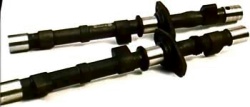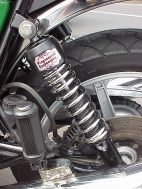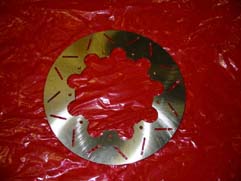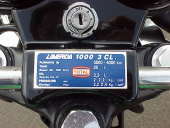The
purpose of this page is to mention some systems considered to be able to improve
Laverda engines running thanks to modern technology, and also others advices.
Please note that you should check with the makers of these systems that the
considered products are really ok for your bike. IGNITION
SYSTEMS:

-
John
Wilson in Australia (see also "Links"), proposes
an electronic ignition system called IIS with very high technology, able to solve
all the old Bosch ignition problems for the 180° triples. (a system exists too
for the 120°). Several advance curves are available and the system solves battery
charging problem. The decisive advantage of the IIS system is that it can include
the whole ignition system and new alternator for the early 1000cc 180 engines,
including the ignition module, the special crank encoders, the HT coils and even
a new alternator (250W). The result is really fantastic, far less vibrations and
noises, torque and power improvment, really good battery charging. Directions
for use are in english and after-sales service is very good, John answering easily
to questions by e-mails or fax. Price is about 360 Euros (500 Australian dollars)
for the module. Any
question? Click here to see the IIS igntion FAQ
Click
here to see how to fit a IIS system
- The MOTO-WITT company,
in Deutchland, products a similar system called DMC for Laverda twins and triples,
with programmable advance curves too. It can be found at Andy Wagner office (Germany)
or at Wolfgang Haerter (Canada) - see "Links" page - The handbook is in Deutch
language or in english (Haerter). Price is around 300 to 390 USD
(Nov. 2001)
depending of model and postage. PRIMARY
TRANSMISSION: WARNING:
September 2004: Two different Laverdists report that they had some problems with
these kits (broken belts). I suggest to anyone who plan to get a belt
drive
kit to contact directly the manufacturers to see if these kits are really adapted
to the using of the bike.
The belt drive kits are conceived to replace the original primary chains,
mainly on triples. They include a new 32 mm engine pulley, a new largeclutch pulley
and a belt which can work in engine oil. According to what the sellers of these
products say, result is fantastic, a smooth running lightweight system, very silencer,
which can provide 2 more HP. When the belt drive is fitted, the primary engine
outrigger bearing can be disconnected but the chain tensionner system is still
used after having removed the rubber and polished the shoe. Two
systems are available: -
The german store Sport-Connection
proposes a belt drive kit for 1000 and 1200 Laverda. These kits fit perfectly
180 and 120 engines without modification. The price (Febr. 2004) for the primary
kit incl. belt, new gasket and screw to close primary cover is eur 450.- the cost
for the high power engine race belt is eur 49.- -
The Australian John
Scerri produces such a kit. Some guys point out some minor
problems which have to be corrected before fitting the system on the bike, especially
a wrong
size of the front pulley for some bikes. Price (Nov. 2001) is around 450 USD +
postage. Since 2002, a new Gen III belt is available, much stronger.
| |
|
| Kit John Scerri |
Kit Sport Connexion |
CAMSHAFTS:
Camshafts
for 750:
To get more horse power from a 750 engine, three models of camshafts
are available: The 2/C, 5/C and 6/C.
- The 2/C were the cams fitted on the
early SFCs with 9,65/1 pistons, heavy crankshaft and Amal then Dell'Orto 36mm
carbs. In my opinion, they are the best choice for the early 750s with their original
heavy crank. They give a powerful engine and match well with these heavy cranks.
Don't expect a very responsive engine at high revs but the pleasure is elsewhere
with good sensations of the powerful but torquy engine.
- The 5/C are the
best choice for the SF1/SF2/SF3 engine type with large valves and light crank,
for a speed-road use or twisty track.
The engine is very responsive but remains
torquy and easy to tune-up. The gain of power is great and the engine is very
pleasant during the acceleration phases, however it keeps a good torque.
- The 6/C give the most powerful engine but to the detriment of the torque at
less than 5800/6000 rpm. The 6/C should be use only on very fast and straight
track.
Camshafts for 1000:
To get more power from a 1000
or 1200 engine, 3 camshaft models: The 4/C, 7/C and the Axtell.
- The 4/C
were fitted on the early endurance racers and on the "true" Jota. They give a
powerful engine, above all higher than 6000 rpm where they are impressive, but
with a slight lack of torque at low revs. The 4/C are the best choice for speed-road
use or on track (except on very fast track, see the 7/C). With high compression
pistons, big valves and 36mm carbs, they are the top of the sensations available
on a Laverda 3C....
- The 7/C must be used only on very fast track. Undoubtedly
that they give the most powerful engine but to the absolute detriment of the torque,
the good range of the engine being beetween 6500 and the red zone... - The Axtell
are a non-Laverda item. The engine get more horsepower and more torque at low
and medium range with original head and carbs.
With large valves, big 36 mm
carbs and HC pistons, the power is impressive. They are
available at Ricky
Racer (USA, see also "Links")
or at
Wolfgang
Haerter (Canada, see also Links).

INLET
STUBS: Tom
Mc Lree (Glasgow, GB
-see "Links" page) proposes new inlet stubs for 1000 (original ones
have a tendency to crack with age). The job done is wonderful and the price is
very low (around 25 LSterling the set of 3- January 2002). He products too an
excellent alternator extractor and top yoke nuts (around 6,5 LS for the extractor).
| |
|
| Inlet stubs |
Alternator extractor |
AIR
FILTERS:
Click
here for a picture
K/N or similar air filter give good results on 750s
and 1000s, except on full power engines (high compr.pistons, hot cams,...) which
require no filter or big air box. It's necessary to check the carburation due
to the bigger amount of air (generarly 2 to 5 points more on the main jets).
EXHAUSTS:
The 750 Laverda
has good performances with the original exhausts, even if some more horsepower
can be expected with the SFC 2 into 1, according to a 5/C or 6/C cam.
For
the triples, especially produced after 1976, free Jota exhausts are a great improvment.
They are available in chromed or in stainless steel.
Click
here for a picture of stainless steel Jota exhausts
SUSPENSIONS:
 | Koni
having stopped its production for motorbikes, you can find good shock absorbers
to Progressive Suspension (California). They propose very good products for Laverda
1000, 3CL, RGS/RGA and SFC (réf.: 412-4220C) at a price of about 240 USD
(May 2002)
Note that Progressive Suspension can allow different colours (chromed
or black bodies or springs) and several spring types.
A great adress to find
PS shocks in the USA:
CYCLEONE,
2401 N Orange Blossom Trail -ORLANDO- Florida. Ask for Ernie. |  |
Click
here to join Progressive Suspension site and to find dealers
BRAKES:
The
first thing to do is to improve the feeling with a "dogleg" lever or
to file some metal off the part of the brake lever that contacts the master cyl
piston.
But the surest way to improve the system is to fit a new
16 mm Brembo MC and "Green" Brembo pads. You can find them at Oro Ricardo
shop in Italy or at Wolfgang Haerter in Canada (see "Links" page).
The look is of course non-original, so you have to make
a choice, original look against efficiency... Replacement
discs brakes: Sport-Connection
proposes
very good steel disc brakes. Look is not like the originals but the braking is
better, especially on the wet. Price is (Febr. 2004) 129 Euros each. 
DECALS:
 | JRS
produces very beautiful copies of original decals for Laverda bikes, especially
the "Total" one (silver foil type on the ignition panel), the "Made
in Italy" (silver foil type on the frame steering head), the "Ceriani"
(white or black), the "Marzocchi", the "Corte e Cosso" or
others "Dell'Orto".
Ask for Mike. | Click
here to join JRS
 TUNING:
3 different ways to improve or to tune a Laverda 1000: Click
here TUNING:
3 different ways to improve or to tune a Laverda 1000: Click
here
|